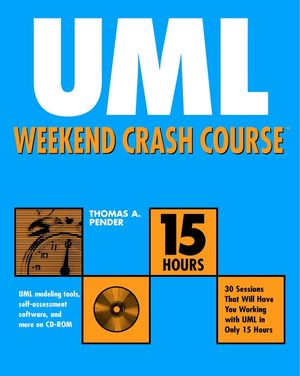UML Weekend Crash CourseISBN: 978-0-7645-4910-6
Paperback
384 pages
July 2002
 |
||||||
Preface.
FRIDAY.
Part I-Friday Evening.
Session 1-What Is the UML?
Session 2-UML and Development Methodologies.
Session 3-How to Approach the UML.
Session 4-Defining Requirements for the Case Study.
SATURDAY.
Part II-Saturday Morning.
Session 5-Understanding the Use Case Model.
Session 6-Building the Use Case Diagram.
Session 7-Building the Use Case Narrative.
Session 8-Identifying the Use Case Scenarios.
Session 9-Modeling the Static View: The Class Diagram.
Session 10-The Class Diagram: Associations.
Part III-Saturday Afternoon.
Session 11-The Class Diagram: Aggregation and Generalization.
Session 12-Applying the Class Diagram to the Case Study.
Session 13-Modeling the Static View: The Object Diagram.
Session 14-Modeling the Functional View: The Activity Diagram.
Session 15-Applying the Activity Diagram to the Case Study.
Session 16-Modeling the Dynamic View: The Sequence Diagram.
Part IV-Saturday Evening.
Session 17-Applying the Sequence Diagram to the Case Study.
Session 18-Modeling the Dynamic View: The Collaboration Diagram.
Session 19-Applying the Collaboration Diagram to the Case Study.
Session 20-Modeling the Dynamic View: The Statechart Diagram.
SUNDAY.
Part V-Sunday Morning.
Session 21-Applying the Basic Statechart to the Case Study.
Session 22-Modeling the Extended Features of the Statechart.
Session 23-Applying the Extended Statechart Features to the Case Study.
Session 24-Modeling the Development Environment.
Session 25-Modeling the Static View: The Component Diagram.
Session 26-Modeling the Static View: The Deployment Diagram.
Part VI-Sunday Afternoon.
Session 27-Introduction to Web Development with Java.
Session 28-Analysis and Architectural Design of a Web Application.
Session 29-Design of a Web Application.
Session 30-UML Modeling Tools.
Appendix A: Answers to Part Reviews.
Appendix B: What's on the CD-ROM?
Glossary.
Index.
End-User License Agreement.
FRIDAY.
Part I-Friday Evening.
Session 1-What Is the UML?
Session 2-UML and Development Methodologies.
Session 3-How to Approach the UML.
Session 4-Defining Requirements for the Case Study.
SATURDAY.
Part II-Saturday Morning.
Session 5-Understanding the Use Case Model.
Session 6-Building the Use Case Diagram.
Session 7-Building the Use Case Narrative.
Session 8-Identifying the Use Case Scenarios.
Session 9-Modeling the Static View: The Class Diagram.
Session 10-The Class Diagram: Associations.
Part III-Saturday Afternoon.
Session 11-The Class Diagram: Aggregation and Generalization.
Session 12-Applying the Class Diagram to the Case Study.
Session 13-Modeling the Static View: The Object Diagram.
Session 14-Modeling the Functional View: The Activity Diagram.
Session 15-Applying the Activity Diagram to the Case Study.
Session 16-Modeling the Dynamic View: The Sequence Diagram.
Part IV-Saturday Evening.
Session 17-Applying the Sequence Diagram to the Case Study.
Session 18-Modeling the Dynamic View: The Collaboration Diagram.
Session 19-Applying the Collaboration Diagram to the Case Study.
Session 20-Modeling the Dynamic View: The Statechart Diagram.
SUNDAY.
Part V-Sunday Morning.
Session 21-Applying the Basic Statechart to the Case Study.
Session 22-Modeling the Extended Features of the Statechart.
Session 23-Applying the Extended Statechart Features to the Case Study.
Session 24-Modeling the Development Environment.
Session 25-Modeling the Static View: The Component Diagram.
Session 26-Modeling the Static View: The Deployment Diagram.
Part VI-Sunday Afternoon.
Session 27-Introduction to Web Development with Java.
Session 28-Analysis and Architectural Design of a Web Application.
Session 29-Design of a Web Application.
Session 30-UML Modeling Tools.
Appendix A: Answers to Part Reviews.
Appendix B: What's on the CD-ROM?
Glossary.
Index.
End-User License Agreement.



